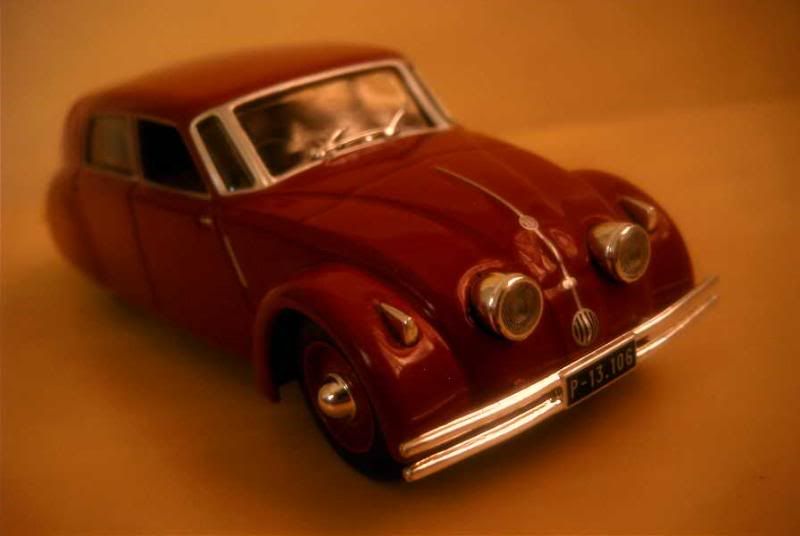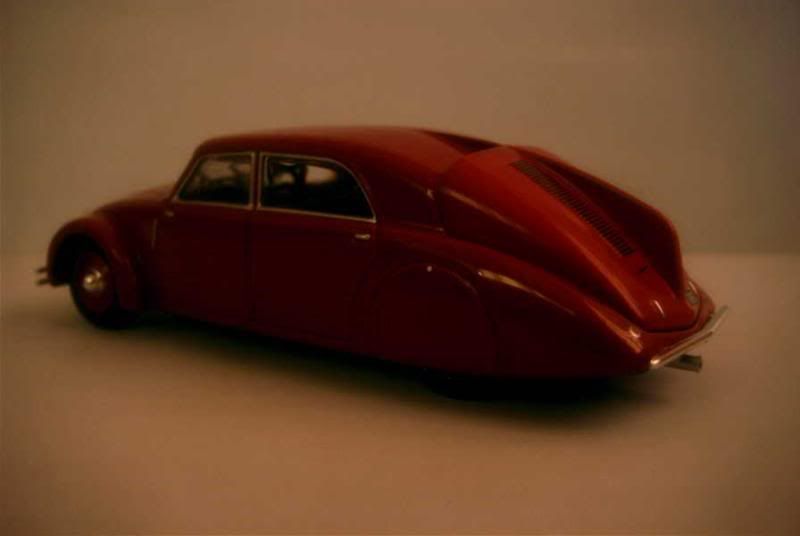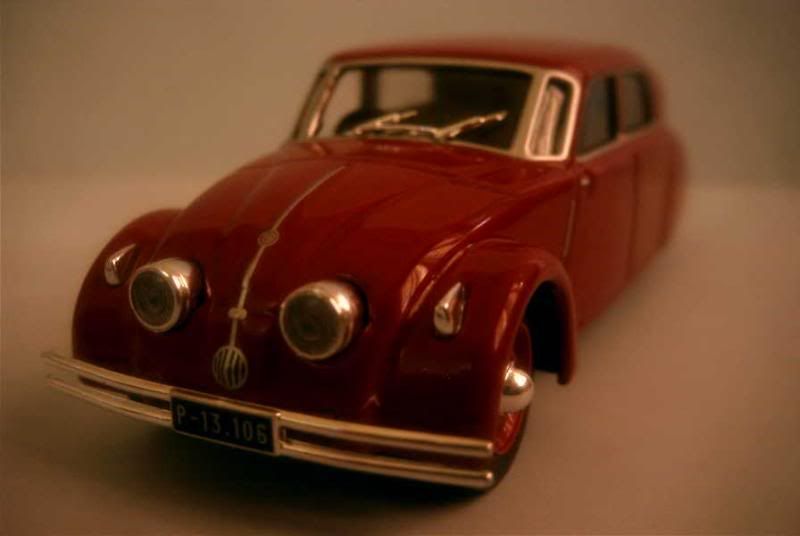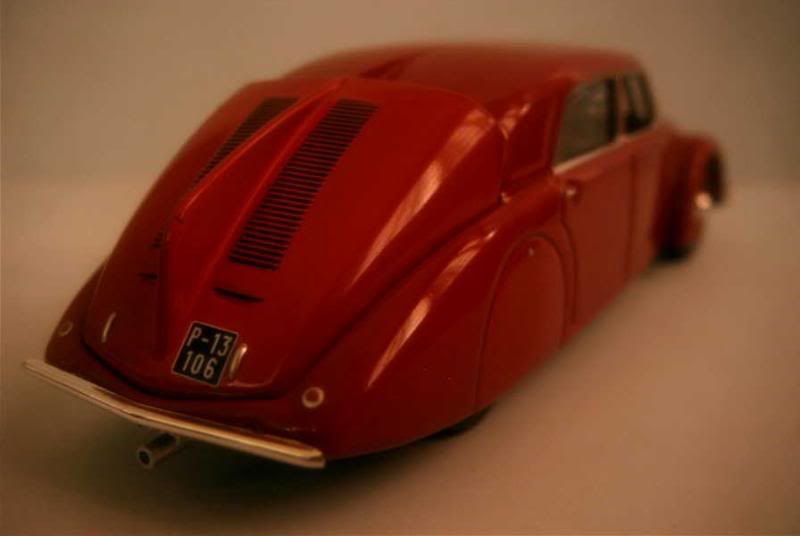A little history
When I was a child, most would have smiled at the evocation of the Czechoslovakian automobiles. The name that sprung to mind was Škoda, and though this company was probably building some of the finest automobiles beyond the Iron Curtain, they were the butt of many jokes in Occident. Fortunately this has changed since then, and today Škoda’s name honours the long history of its country’s motor industry. Until WW2, it was a very busy one, but none among the Czechoslovakian manufacturers could challenge Tatra’s position at the frontline of technical innovation.
Tatra already had a long history as an automobile manufacturer, having set a foot into motor industry as early as 1897, when it was still called Nesselsdorf and belonged to the Austro-Hungarian empire. The dismantlement of the country, following the end of WW1, also brought a new name, taken from the nearby Tatra mountain range. In 1921, Hans Ledwinka, an engineer with a head full of original ideas, took over the company’s design department, and Tatra set on an innovation spree. Soon, all Tatra models used air-cooled rear engines, which were not a common feature at the time. Perhaps even more striking were the independent suspension on all four wheels, while most other cars still had two rigid axles, mounted on a backbone chassis. Using this common architecture for all of its models, Tatra developed a range extending from popular models to luxury automobiles.
In 1934, Tatra succeeded in outdoing itself with the striking T77, introduced at the Prague motor show in May. Many were still toying with streamlined prototypes, some being produced in tiny series such as the Pierce Silver Arrow, when Tatra proposed the very first production streamlined automobile. And unlike the aforementioned American car, the T77 would have road characteristics and mechanical features to match its arresting appearance.
By then a specialist of rear-engine vehicles, Tatra was well positioned to create an aerodynamic car, as the absence of a transmission tunnel allowed a much lower automobile. As seen from the side, the T77 looked more as an airplane’s wing than any of the box-like cars of the Thirties. The T77’s overall shape was due to famed aerodynamic specialist Paul Jaray, a former Zeppelin engineer, and reached an astonishing coefficient of drag of only 0.212. Hans Ledwinka took care of the mechanical part. Positioned to the extreme rear of the car, the large 3.0-litre V8 avoided creating too much of an unbalance that would have been damageable to the car’s handling by being largely built in light alloy, as was the gearbox. With no more than 60 hp, the T77 could reach a 145 kph top speed, a rare performance back then, in perfect comfort.
The T77 received rave reviews from the press, and enthralled its rich and often famous owners. As early as 1935, the original T77 evolved into the T77A, with an enlarged 3.4-litre engine. With now 75 hp at his or her disposal, a T77 driver could now reach 150 kph. The T77A’s style also evolved, the headlights being repositioned on the front wings in order to increase the impression of extreme width of the car. A third headlight, sometimes steerable in turns, was also added up front.
The Tatra T77 certainly remained one of the most advanced automobiles in the world until 1938, when its production was interrupted and the T87 took its place. This remarkable automobile had inaugurated a line of highly aerodynamic, rear-engine Tatra saloons that would last for four decades.
About the model
Model: Tatra T77
Year: 1934
Maker: Ixo
Scale: 1/43
Distributed by: Altaya as no.37 of its Voitures Classiques press series
Acquired: brand new, in April 2007, in Souillac, France
Excellent model by Ixo in this noteworthy Altaya series: 14/20. Note the rear fin needed to stabilize the car at high speeds.




When I was a child, most would have smiled at the evocation of the Czechoslovakian automobiles. The name that sprung to mind was Škoda, and though this company was probably building some of the finest automobiles beyond the Iron Curtain, they were the butt of many jokes in Occident. Fortunately this has changed since then, and today Škoda’s name honours the long history of its country’s motor industry. Until WW2, it was a very busy one, but none among the Czechoslovakian manufacturers could challenge Tatra’s position at the frontline of technical innovation.
Tatra already had a long history as an automobile manufacturer, having set a foot into motor industry as early as 1897, when it was still called Nesselsdorf and belonged to the Austro-Hungarian empire. The dismantlement of the country, following the end of WW1, also brought a new name, taken from the nearby Tatra mountain range. In 1921, Hans Ledwinka, an engineer with a head full of original ideas, took over the company’s design department, and Tatra set on an innovation spree. Soon, all Tatra models used air-cooled rear engines, which were not a common feature at the time. Perhaps even more striking were the independent suspension on all four wheels, while most other cars still had two rigid axles, mounted on a backbone chassis. Using this common architecture for all of its models, Tatra developed a range extending from popular models to luxury automobiles.
In 1934, Tatra succeeded in outdoing itself with the striking T77, introduced at the Prague motor show in May. Many were still toying with streamlined prototypes, some being produced in tiny series such as the Pierce Silver Arrow, when Tatra proposed the very first production streamlined automobile. And unlike the aforementioned American car, the T77 would have road characteristics and mechanical features to match its arresting appearance.
By then a specialist of rear-engine vehicles, Tatra was well positioned to create an aerodynamic car, as the absence of a transmission tunnel allowed a much lower automobile. As seen from the side, the T77 looked more as an airplane’s wing than any of the box-like cars of the Thirties. The T77’s overall shape was due to famed aerodynamic specialist Paul Jaray, a former Zeppelin engineer, and reached an astonishing coefficient of drag of only 0.212. Hans Ledwinka took care of the mechanical part. Positioned to the extreme rear of the car, the large 3.0-litre V8 avoided creating too much of an unbalance that would have been damageable to the car’s handling by being largely built in light alloy, as was the gearbox. With no more than 60 hp, the T77 could reach a 145 kph top speed, a rare performance back then, in perfect comfort.
The T77 received rave reviews from the press, and enthralled its rich and often famous owners. As early as 1935, the original T77 evolved into the T77A, with an enlarged 3.4-litre engine. With now 75 hp at his or her disposal, a T77 driver could now reach 150 kph. The T77A’s style also evolved, the headlights being repositioned on the front wings in order to increase the impression of extreme width of the car. A third headlight, sometimes steerable in turns, was also added up front.
The Tatra T77 certainly remained one of the most advanced automobiles in the world until 1938, when its production was interrupted and the T87 took its place. This remarkable automobile had inaugurated a line of highly aerodynamic, rear-engine Tatra saloons that would last for four decades.
About the model
Model: Tatra T77
Year: 1934
Maker: Ixo
Scale: 1/43
Distributed by: Altaya as no.37 of its Voitures Classiques press series
Acquired: brand new, in April 2007, in Souillac, France
Excellent model by Ixo in this noteworthy Altaya series: 14/20. Note the rear fin needed to stabilize the car at high speeds.







4 comments:
Please note that the T77 of 0.212 is most probably based on a 1:5 model test, not a real car. T87 1:5 model test measured 0.244.
Thanks a lot for your comment! Actually I remember hesitating adding this figure when writing this post as I found it quite hard to believe. You probably give the best explanation.
excelent model, excelent car, excelent history.
thanks for a kind moment of good reading.
Thanks a lot Gaucho Man! :)
Post a Comment